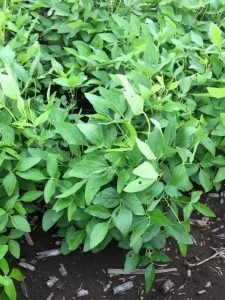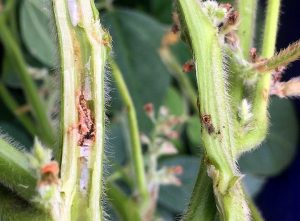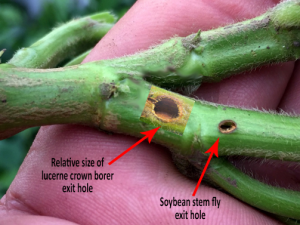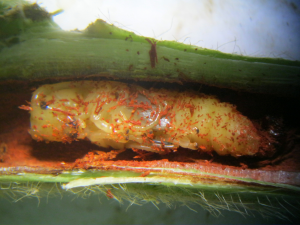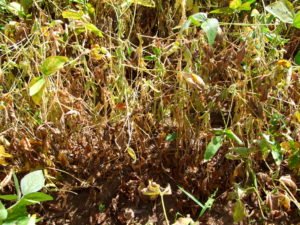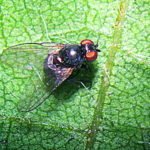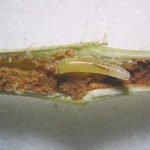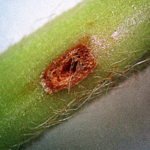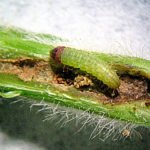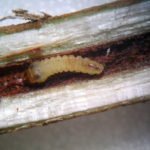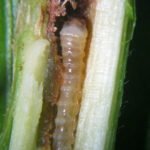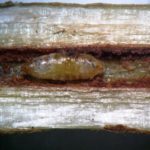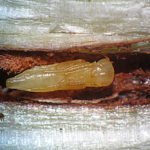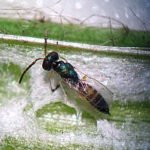Outbreak report (February 2018): Soybean stem fly (Melanagromyza sojae) was detected in late January, 2018 in a 6-week old soybean crop near Casino, NSW. At the time of detection, most stem fly in the crop were in the pupal stage. There were no plant ill health symptoms (e.g. wilting/death), despite numerous exit holes made by larvae prior to pupation. These holes are made by ‘about to pupate’ larvae to allow adult flies that emerge post pupation, to exit the stem.
In the last major outbreak (Casino 2013), many crops were also infested with charcoal rot, which produces similar plant death/wilting symptoms (see image below), and which made the attribution of damage to stem fly quite difficult. Growers/consultants are therefore asked to closely watch any stem fly infected crops and report any damage symptoms in crops with and without charcoal rot.
- Soybean stem fly adult (2 mm)
- Larva (4 mm) tunnelling in pith in the plant’s stem
- Soybean stem fly exit hole (2 mm internal diameter) made by larva prior to pupation
Note that two other pests (lucerne crown borer or Zygrita, and etiella) can also tunnel in soybean stems and cause similar damage, i.e. eaten out and brown, discoloured pith (see below). Any agronomic measures to reduce plant stress, particularly irrigation, will also help mitigate the impacts of stem fly, crown borer and charcoal rot.
- Etiella (5 mm; grows to 12 mm)
- Zygrita small larva (4 mm)
- Zygrita larva (12 mm; grows to 25 mm)
Insecticide options: Currently there are no insecticides currently registered or under permit for soybean stem fly control in soybeans. In 2013, an emergency permit (PER 14121 – now lapsed) was issued for dimethoate, in response to the major outbreak at Casino. The permit rate of 800 mL/ha was based on levels registered for ordinary beanfly (Ophiomyia phaseoli) in other susceptible pulses such as navy beans.
Experience from the 2013 outbreak showed that dimethoate at this high rate did not reverse the damage symptoms in severely damaged crops, but did flare silverleaf whitefly. Unknown at this stage are whether damage would have been reduced with more timely spray applications (i.e. earlier in the pest’s infestation cycle), the potential for more selective insecticide options for this pest, and if the damage symptoms were primarily caused by the stem fly or charcoal rot.
Spray timing: No matter which products are eventually registered against or secure a permit for stem fly control, spray timing is likely to be important. In a crop where most stem fly are in the pupal stage (as reported at Casino), spraying would be ineffective, as the pupal stage does not feed, and therefore would not take up any insecticide. However, as the crop could be reinfested with the offspring of flies emerging from these pupae, systemic insecticides targeting these larvae (while they are still young and before they reach the main stem) may have potential, but trials are required to verify this hypothesis.
The current detection will be closely monitored to see if any crop wilting/death symptoms develop. If the crop is reinfested and develops damage symptoms, and if similar damage is widely reported in other crops with little obvious charcoal rot, then an emergency use permit application will submitted for stem fly control. If this occurs, details will be included in a future Beatsheet article.
Check your crops: Growers and consultants in all coastal soybean regions are advised to check their crops for stem fly. In the severe 2013 outbreaks, swarms of the small black adult flies were readily observed, both visually and in sticky traps. Check stems for tunnelling in the pith, and for the tell-tale exit holes. Inspect damaged plants closely to determine which pith-tunnelling pest is responsible. Note that plants can be infested by more than one pest, and that lucerne crown borer is very common in many regions, Check that pupae in the stem are those of soybean stem fly, as small native parasitic wasps were recorded in significant numbers in the latter stages of previous stem fly outbreaks. The adult parasitoid’s shape is evident in the wasp pupa.
- Soybean stem fly pupa (3 mm)
- stem fly parasite pupa (4 mm)
- Parasitoid wasp Eupelmidae sp. (2.5 mm)
Please report any suspected soybean stem fly infestations to both your local agronomist and one of the researchers below:
- Hugh Brier, DAF Kingaroy (07) 41 821 840 or 0428 188 069 ([email protected])
- Liz Williams, DAF Kingaroy (07) 41 821 818 or 0476 850 415 ([email protected])
- Natalie Moore, NSW DPI (02) 66 401 637 ([email protected])
Article by Hugh Brier and Liz Williams. Insect photos by Joe Wessels. March crop photos by Mark Carter, BGA, Casino.

